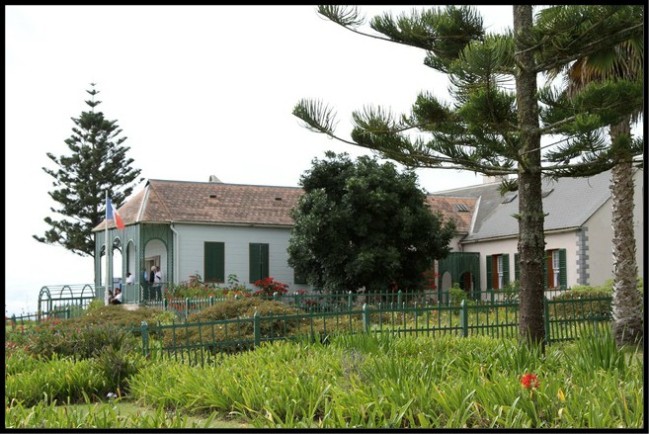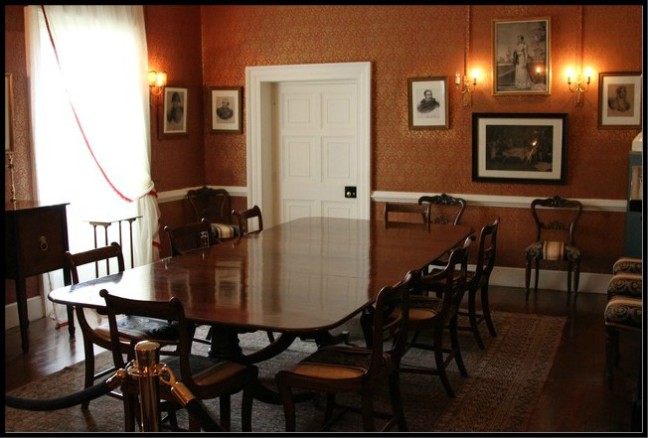
Napoleon had been exiled to St Helena following his defeat at the Battle of Waterloo in 1815. Napoleon was not impressed with St Helena and on his first sighting of the island is said to have referred to it as ‘questa piedra maladetta’ – ‘this cursed rock’ – adding, ‘Better we had stayed in Egypt.’
Napoleon was equally unimpressed with what was to be his final home – Longwood House – which he moved into on 10 December 1815 after a temporary sojourn at Briar’s Pavilion. He found it to be dark, cold, damp, windswept, festooned with cobwebs and rats – a far cry from the Élysée and Tuileries of his glory days.
Numerous letters complaining about living conditions here from Napoleon to Governor Lowe, who held him in great disdain, went unanswered. Napoleon did not hold Lowe in high esteem either remarking once to his physician, “He has the look of a criminal stamped on his face”. The Times of London published articles insinuating that the British government was trying to hasten Napoleon’s death by keeping him in this residence. Much of Napoleon’s time at Longwood was passed by dictating his memoirs, and by playing billiards.

Following Napoleon’s death, Longwood House reverted to the East India Company and later to the Crown and into a state of disrepair. There was no desire to create a shrine to someone who, after all, was an enemy of Britain. On hearing of this neglect Napoleon III negotiated for its transfer to France which occurred in 1858 (as did the site of Napoleon’s Tomb).
On my visit I found the house to be newly painted and restored, following an international fund-raising effort by the resident French Consul. You may, as I did, wonder at the need for a French consul on an island where there is only one French person, that being the consul himself! As I have indicated elsewhere there are three areas of French Territory on St Helena – Longwood House and Gardens, Briar’s Pavilion and Napoleon’s Tomb. The Consul is essentially a caretaker for these three properties.
Longwood House is set in small but beautiful regimented grounds (designed by Napoleon himself) and is packed with Napoleonic memorabilia – down to a lock of Napoleon’s hair, a replica of the camp bed in which Napoleon died and a copy of his death mask.
Perhaps most poignant though are the portraits of the empresses Josephine and Maria Louisa and the bust of the so-called King of Rome, Napoleon’s legitimate son none of who Napoleon was allowed to see again after his second abdication as Emperor on 22 June 1815. This upset him more than anything else.
Napoleon died in Longwood House on 5 May 1821. I comment further on his death in a separate tip on Napoleon’s Tomb. Did he really die from the wallpaper?
The house can visited by way of free guided tour at 11.00 am Monday – Friday. Do check with the tourist office in Jamestown to confirm opening times before going out to the house. I managed to get in somewhat earlier one morning for a self guided tour before an onslaught of tourists from a cruise liner which visited during my stay. Staff awaiting the arrival of cruise liner tourists provided me with tonnes of great information as I wandered around this “former prison cell” thinking that it was quite acceptable by my standards, if not Napoleon’s. I suspect, however, that the French now look after the maintenance somewhat more assiduously than Governor Lowe did in the early 1800s.
I understand that the Governor’s residence, Plantation House, has a chandelier in the dining room, taken by Lowe from Longwood House after Napoleon died. Also, and this I know, if you visit Farm Lodge on Rosemary Plain (a former planters residence and now a small hotel – see my separate review) you can see an original wine-cooler acquired from Longwood, while you enjoy a coffee seated on Napoléon’s original chaise longue.
This blog entry is one of a group (loop) of entries on my trip to St Helena. I suggest you continue with my next entry – Napoleon I – His St Helena Tomb – or to start the loop at the beginning go to my St Helena Introduction entry.

The dining room looks quite presentable in your photo, though it is certainly possible, as you say, “that the French now look after the maintenance somewhat more assiduously that Governor Lowe did in the early 1800s.”
(One typo, by the way: I think you must have meant 1858, not 1958.)
LikeLiked by 1 person
Thanks for the pick up of typo Don .. it and another one fixed 🙂
LikeLike
Actually I don’t think it was 1558 either. Both the French and the English were preoccupied with the Siege of Calais in that year.
LikeLiked by 1 person
Oh my goodness, hopefully third time lucky… thank you 🙂
LikeLike
For a man who held Europe hostage this is a humbling abode indeed. It had to be far away enough for him not to escape and cause chaos once again!
LikeLiked by 1 person
Yes, I like the comments the Duke of Wellington made in the letter I quoted on this entry..
https://ramblingwombat.wordpress.com/2017/02/20/briars-pavilion-napoleons-bedsit/#more-3329
LikeLiked by 1 person